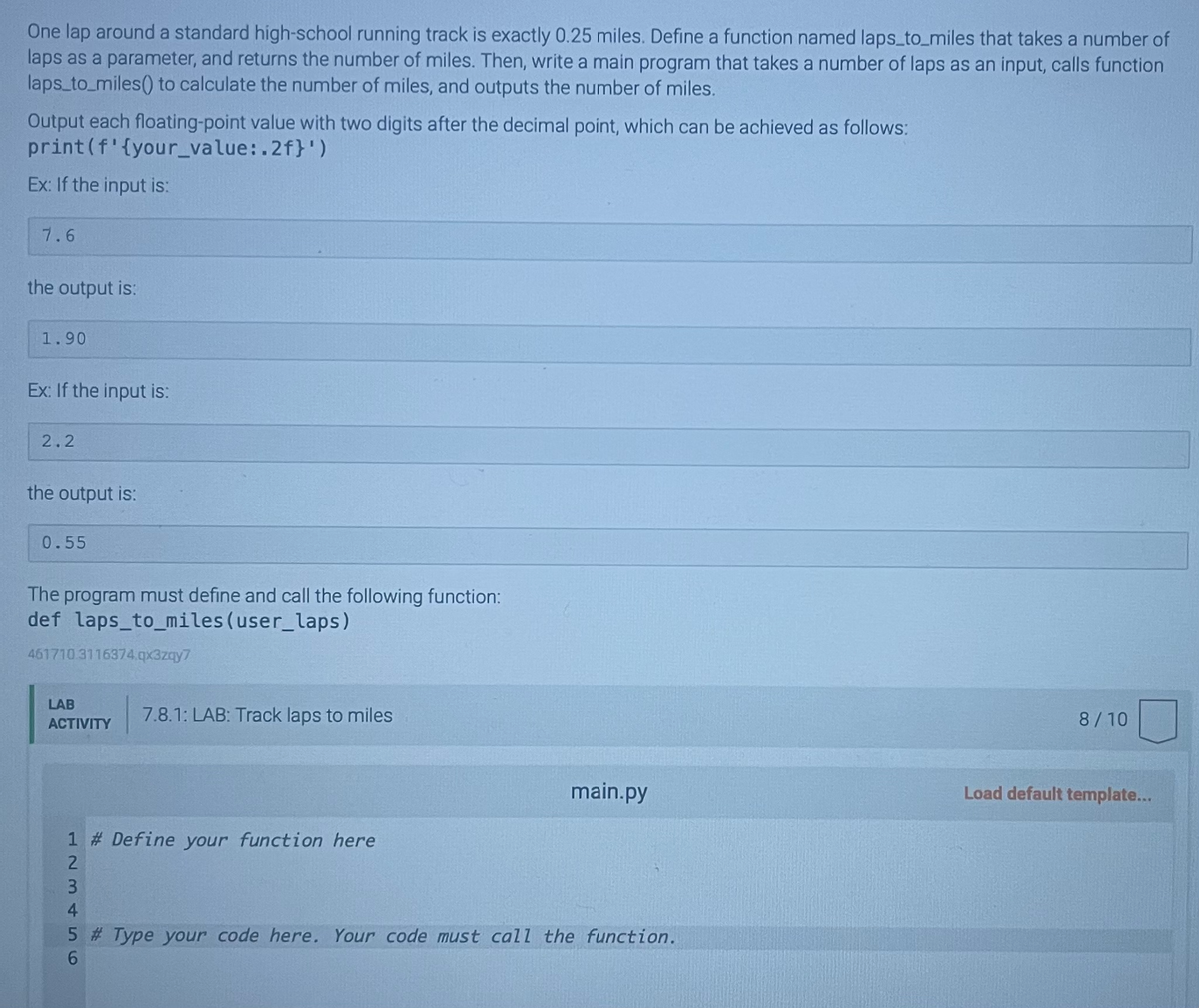One lap around a standard high-school running track is exactly 0.25 miles. Define a function named laps_to_miles that takes a number of laps as a parameter, and returns the number of miles. Then, write a main program that takes a number of laps as an input, calls function laps_to_miles() to calculate the number of miles, and outputs the number of miles. Output each floating-point value with two digits after the decimal point, which can be achieved as follows: print (f' {your_value:.2f}') Ex: If the input is: 7.6 the output is: 1.90 Ex: If the input is: 2.2 the output is:
One lap around a standard high-school running track is exactly 0.25 miles. Define a function named laps_to_miles that takes a number of laps as a parameter, and returns the number of miles. Then, write a main program that takes a number of laps as an input, calls function laps_to_miles() to calculate the number of miles, and outputs the number of miles. Output each floating-point value with two digits after the decimal point, which can be achieved as follows: print (f' {your_value:.2f}') Ex: If the input is: 7.6 the output is: 1.90 Ex: If the input is: 2.2 the output is:
C++ for Engineers and Scientists
4th Edition
ISBN:9781133187844
Author:Bronson, Gary J.
Publisher:Bronson, Gary J.
Chapter6: Modularity Using Functions
Section6.1: Function And Parameter Declarations
Problem 3E
Related questions
Question

Transcribed Image Text:One lap around a standard high-school running track is exactly 0.25 miles. Define a function named laps_to_miles that takes a number of
laps as a parameter, and returns the number of miles. Then, write a main program that takes a number of laps as an input, calls function
laps_to_miles() to calculate the number of miles, and outputs the number of miles.
Output each floating-point value with two digits after the decimal point, which can be achieved as follows:
print (f' {your_value:.2f}')
Ex: If the input is:
7.6
the output is:
1.90
Ex: If the input is:
2.2
the output is:
0.55
The program must define and call the following function:
def laps_to_miles (user_laps)
461710.3116374.qx3zqy7
LAB
ACTIVITY
1 # Define your function here
2
456WNI
3
4
7.8.1: LAB: Track laps to miles
6
main.py
5 # Type your code here. Your code must call the function.
8/10
Load default template...
Expert Solution
This question has been solved!
Explore an expertly crafted, step-by-step solution for a thorough understanding of key concepts.
This is a popular solution!
Trending now
This is a popular solution!
Step by step
Solved in 3 steps with 3 images

Knowledge Booster
Learn more about
Need a deep-dive on the concept behind this application? Look no further. Learn more about this topic, computer-science and related others by exploring similar questions and additional content below.Recommended textbooks for you

C++ for Engineers and Scientists
Computer Science
ISBN:
9781133187844
Author:
Bronson, Gary J.
Publisher:
Course Technology Ptr

C++ Programming: From Problem Analysis to Program…
Computer Science
ISBN:
9781337102087
Author:
D. S. Malik
Publisher:
Cengage Learning

C++ for Engineers and Scientists
Computer Science
ISBN:
9781133187844
Author:
Bronson, Gary J.
Publisher:
Course Technology Ptr

C++ Programming: From Problem Analysis to Program…
Computer Science
ISBN:
9781337102087
Author:
D. S. Malik
Publisher:
Cengage Learning